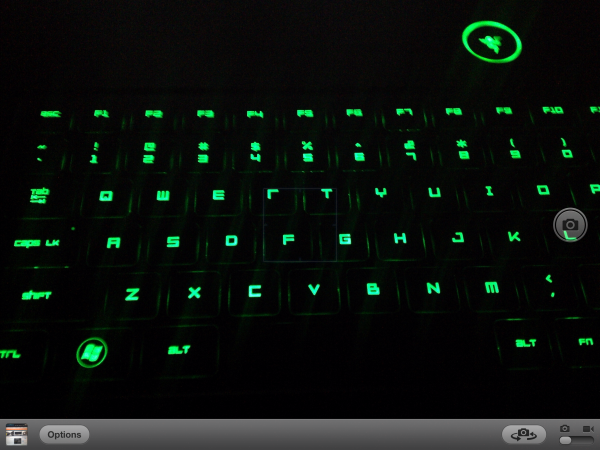The Apple iPad Review (2012)
by Vivek Gowri & Anand Lal Shimpi on March 28, 2012 3:14 PM ESTThe Camera, It's Much Improved
by Vivek Gowri
iOS 5.1 brought with it a number of bugfixes along with a few minor changes to the core entertainment applications (Music, Photos, Videos), but the only real UI change it brought was the redesigned camera application for the iPad. It fixes our biggest complaint with the original—the shutter button’s location in the middle of the settings bar at the bottom of the screen—and ends up being a big improvement from a usability standpoint. The shutter now resides in a floating circular button on the right side of the display, right where your right thumb falls when holding the iPad with two hands. It’s a more intuitive location for the shutter, so taking a picture is a far more natural feeling exercise than it was before. Other than that, the app looks pretty similar—the settings bar now has the still/video slider, front/rear camera switch, an options button, and the link to the photo gallery.
In terms of camera options, there’s only one. You can either have the rule of thirds grid overlay visible or hidden....and that’s it. There’s no other settings for you to change. No exposure, white balance, ISO, shutter speed, or anything else that isn’t the shutter button. Unfortunately, even the HDR mode from the 4 and 4S is nowhere to be found on the iPad. You literally just point and shoot. That’s all there is for you to do.
In our review of the iPad 2, we summed up the cameras with just one word, mediocre. Looking back, I realize now that the word mediocre is a pretty charitable way to describe the iPad 2’s camera situation. Both sensors were borrowed from the iPod touch, and while the VGA front facing camera was acceptable, the rear facing 720p camera was legitimately bad by the standards of a $499 device.
The new iPad fixes that rear camera problem in a big way, with the five element f/2.4 lens and optics borrowed from the iPhone 4S paired with the Omnivision OV5650 CMOS image sensor from the iPhone 4. A quick refresher on specs: 5 megapixels, backside illuminated, 1080p video at 60fps. If you ignore megapixel count, it’s a pretty competitive camera on paper. There’s a lot of recycled parts here, with bits and pieces from other iDevices frankensteined together to come up with a new imaging system for the iPad, but parts-bin raids aren’t bad when the bins being raided from contain top-tier components. The result ends up being pretty good—as a camera, the new iPad is light years ahead of its predecessor in basically every way.
In practice, it’s nothing short of stellar. Image quality is comparable to most high end smartphones, though not quite good enough to be on par with the bleeding edge cameraphones (4S, Nokia N8/N9, HTC Amaze 4G, Galaxy S 2, etc). Interestingly enough, the preview image looks to be running below 30 fps, appearing a little bit choppy at times. This is likely due to the high resolution of the preview and upscaling it to a very high display resolution, but it doesn’t particularly affect image capture. I measured shot to shot time at exactly one second (I had a range between 0.98 and 1.04 seconds, averaged out to 1.0 when factoring in reaction time). That’s about double what Apple claimed for the 4S, and a bit longer than the iPad 2. Granted, the iPad 2’s camera was very quick in part because the amount of processing it takes to capture a 960x720 image is almost zero, with about 13.8% as many pixels as each 2592x1936 image captured by the new iPad.
The focal length is 4.28mm, a bit longer than the iPad 2’s 3.85mm. The difference is actually noticeable; when taking pictures of nearby subjects, you’re sometimes surprised by how magnified the subject appears. However, the camera is good for landscapes, as you can see from the sample gallery. I took the iPad with me on a weekend trip to Victoria, B.C. and used it as my primary camera on the trip. Now, while I wouldn’t trade my SLR for an iPad anytime soon, I can’t deny that the results turned out pretty well. Colours were vibrant, white balance was accurate, and the clouds were nicely highlighted. It’s a quantum leap from the noisy, 0.7MP mess that was the iPad 2 camera. Mouse over the links below to see some comparisons between the cameras on the iPad 2, 3rd gen iPad and TF Prime.

| Apple iPad 2 | Apple iPad (3rd gen) | ASUS TF Prime |
| original | original | original |

| Apple iPad 2 | Apple iPad (3rd gen) | ASUS TF Prime |
| original | original | original |
The new sensor can record 1080p video, up from 720p. Video quality was probably the best aspect of the iPad 2 camera, and it's even better here. Output is recorded at 29.970 fps and encoded in h.264 Baseline with a bitrate of 21Mbps and single channel audio at 64kbps. The recorded video impresses, with crisp detailing and adequate audio quality from the single mic.
The front facing camera keeps the Omnivision OV297AA sensor from the iPad 2, and as such, image and video quality remain unchanged. It’s not necessarily a bad thing, since it remains adequate for FaceTime and Skype, but it would have been nice to see an update to an HD-quality webcam up front.
With augmented reality apps, I’m starting to see the benefit of rear cameras on tablets. For example, the Yelp app, which takes location and compass data to display what restaurants are the direction the iPad is pointing, with a real-time street view of the search results. It’s not necessarily the most useful way to use the rear facing camera in an AR application, but overall it’s an idea that has potential. Apple also tells us that its business and education customers see usefulness in the iPad's rear facing camera as they can use it to quickly document something while using the iPad as a productivity tool. As a consumer, you’re going to get weird looks if you’re using the iPad to take pictures though, it’s a relatively comical sight.
And that’s really the problem: from an ergonomic standpoint, smartphones are just so much easier and more comfortable to use as cameras. And because the imaging hardware is so similar, I’m not sure I see the real benefit of having a rear facing camera on a tablet except in very specific use cases.

























234 Comments
View All Comments
jjj - Wednesday, March 28, 2012 - link
Testing battery life only in web browsing ? Maybve that would be ok for a 100$ device.As it is the battery tests are prety poor,you do video playback when every SoC out there has a dedicated decode unit and that test is only representative for vid playback.Here the most important test should have been battery life when both GPU and CPU are loaded and not including that seems like an intentional omission to avoid makiing the device look bad.There are a lot of other things to say about the review,too many but one thing has to be said.
This is a plan B or plan C device.The screen is the selling point,is what had to go in,they didn't had 28/32nm in time and had to go for a heavier,thicker,hotter device with a huge chip (CPU speed is limited most likely by heat not so much power consumption,ofc both are directly related).Apple had to make way too many compromises to fit in the screen,no way this was plan A.
tipoo - Thursday, March 29, 2012 - link
I would have liked a gaming battery life test as well.PeteH - Thursday, March 29, 2012 - link
Beyond even that, I'd like to see a worst-case battery life (i.e. gaming, max brightness, LTE up, etc).Also, it'd be really interesting to see how brightness impacts battery life. Maybe the web browsing test at 20%, 40%, 60%, 80%, and 100% brightness. Of course that would probably delay the review by several days, so it might not be worth it.
Anand Lal Shimpi - Thursday, March 29, 2012 - link
We did a max brightness test, however a gaming test would be appropriate as well. I will see if I can't run some of that in the background while I work on things for next week :)Take care,
Anand
SimpleLance - Wednesday, March 28, 2012 - link
The biggest drain for the battery comes from the display. So, if the iPad will be used for hotspot only (with display turned off), you will get a lot of hours from it because it has such a huge battery.But then, using the the iPad just for a hotspot would be a waste of that gorgeous display.
Very nice review of a very nice product.
thrawn3 - Wednesday, March 28, 2012 - link
Am I the only one that feels the max brightness is more important in day to day use of a highly portable device than DPI and color accuracy?I absolutely would love to have all of these three be excellent but I think for a tablet or small laptop Max Brightness and DPI are higher priority than color accuracy. This is exactly what the ASUS Transformer Infinity is supposed to be but I would prefer it on a real laptop.
I care about color accuracy too but I am perfectly fine with needing a desktop monitor and trading brightness there since it is in a stable environment until we hit the technological level that will allow all these elements to be combined. Maybe quantum dot display technology in the future?
One thing I have to give all these new displays is that they FINALLY have gotten the wide viewing angles thing right and I will be so happy to get this into the rest of the market.
seapeople - Tuesday, April 3, 2012 - link
Would you really prefer a bright 1366x768 TN panel with 200 contrast ratio on a 15" laptop over a less bright IPS Ipad screen with much better resolution, DPI, color accuracy, and viewing angle?vision33r - Wednesday, March 28, 2012 - link
The screen is really gorgeous when you shoot raw with any DSLR and view it in iPhoto.ol1bit - Wednesday, March 28, 2012 - link
I just bought a Asus Transformer Prime, and your review was spot on with what I decided. I can not live with IOS and using Android for 3 years.Just the simple stuff was my decision:
1. Freedom of Android, file transfers, etc. No Itunes requirement.
2. MicroSD
3. Kewl keyboard
4. Live Wallpaper.
5. A real desktop, separate from my applications.
6. 32GB versus 16GB
7. Gorilla Glass (yes, true. My original droid lived in my pocket 2 years no scratches, my HTC Rezound scratches the first 2 weeks).
8. Asus (love their MBs)
9. Nivida (love their GPUs)
What I will miss:
1. Ipad 3 Display.
darkcrayon - Thursday, March 29, 2012 - link
1. iTunes is no longer ever needed for an iOS device. I consider the option of a first party desktop sync solution to be an advantage now that it's not a requirement.7. It seems likely the new iPad uses Gorilla Glass or Gorilla Glass 2...
9. Odd that you'd love nVidia's GPUs when they've been pretty much the bottom of the performance barrel for ARM device graphics, even excluding Apple's SoCs (which have lately been using the fastest GPUs in the industry by far).